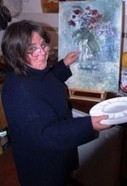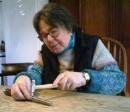.................... .925 Silver (Sterling Silver)?
To make silver durable enough for use in jewellery, pure silver, which has a .999 fineness (99.9%), is often alloyed with small quantities of copper (7.5%). The copper is added to strengthen the silver and the resulting product is .925 sterling silver (92.5%). Acceptable quality marks for sterling silver include: sterling, sterling silver, ster, and .925.
This is the same standard as English Hall Marked Silver and is what I use as I do not have my own personal hallmark from the assay office.
.................................A Semi-Precious Stone?
Any gemstone that is not a diamond, ruby, emerald or sapphire is a semi-precious gemstone.
Calling a gemstone semi-precious does not mean it is less valuable than precious gemstones.
Semi-precious gemstones are just usually more abundant (but there are a few exceptions).
The value given to semi-precious gemstones depends largely on colour, availability and quality.
Because these gemstones typically have more sources, they are a good choice for larger, clean-eye stones
and come in a rainbow of colours.
Calling a gemstone semi-precious does not mean it is less valuable than precious gemstones.
Semi-precious gemstones are just usually more abundant (but there are a few exceptions).
The value given to semi-precious gemstones depends largely on colour, availability and quality.
Because these gemstones typically have more sources, they are a good choice for larger, clean-eye stones
and come in a rainbow of colours.
.......................Fine Silver?
(also known as PMC or Precious Metal Clay)
The Fine Silver that I use is a reclaimed and re-cycled metal clay crafting medium consisting of very small particles of silver, mixed with an organic binder and water for use in making jewellery, beads and small sculptures. Originating in Japan in 1990, metal clay can be shaped just like any soft clay, by hand or using moulds.
Once the metal clay is dry, you can shape it and drill it with a simple tools and generally refine and clean your design.
Finally the clay is fired in a kiln to drive off the water and binder leaving an individual artisan piece of jewellery in solid Fine Silver of up to .999 purity.
Once the metal clay is dry, you can shape it and drill it with a simple tools and generally refine and clean your design.
Finally the clay is fired in a kiln to drive off the water and binder leaving an individual artisan piece of jewellery in solid Fine Silver of up to .999 purity.
.............Printmaking?
Printmaking is basically transferring an image from a surface or "plate" you have made. I usually use metal, lino, card or perspex.
When I use metal it gets eaten by acid (etched), scratched, bashed or marked in other ways.
Lino gets carved into as does perspex, while in the collagraph method the surface is built up and textured in various ways.
Lino cutting is a simpler process where you carve out the areas of lino that you want to stay the colour of the paper you are printing on.
You still have to "pull" the print under pressure through the press.
The Collagraph method is a bit like etching, but the plate is built up and then sealed with shellac before printing.
Prints can be from an edition where they are marked as a fraction of the total number printed e.g. 7/16, or can be marked A/P which means artist's proof.


